|
Bloggery - Highlights - Archives
Back in Time
December 11, 2010 - View Single Entry
You could spend several days at the Norsk Folkemuseum and not exhaust the possibilities. Here's what caught my attention during the couple of hours I spent there. A bonus was the annual Christmas fair, which takes place the first two weekends in December. That's where I bought my slippers.
This stave church was built around 1200; "stave" refers to the construction method, which used pillars to support the roof. Like the many other buildings in the the "open-air museum," this one was moved here from somewhere else.
| This is detail from one of the church doors. Did those very long winter nights encourage wood carving? Very long sea voyages encouraged carving too, on whatever materials were available. |
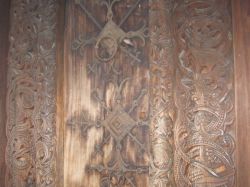 |
The gallery on the left is from the stave church, but modest dwellings had them too. I think the house on the right was built in the late 16th century. (I really should have made notes.) There's a narrow aisle between the outer and inner walls -- for what I don't know. Storage? Defense? You have to duck low to get through that doorway. My first thought was that smaller openings were easier to cover to prevent precious heat from escaping. Someone suggested, though, that if the householder didn't like who was coming through, the low doorway made it easier to lop his head off. Makes sense!
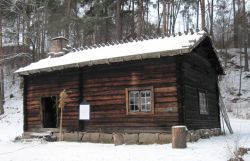
I'm pretty sure this farmhouse was built later than the one above. The door is bigger, and it's got windows. The various houses were decorated for Christmas in their various eras, and some featured actors in period dress.
On the right is a semi-permanent storage hut of the nomadic "reindeer people," the Sami. Next to it was a dwelling in the familiar tipi shape. On the left a would-be reindeer wrangler practices roping a wooden reindeer.
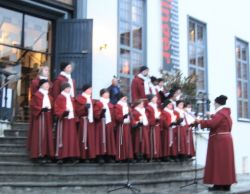
This hardy choir sang carols in the courtyard to a warmly dressed SRO audience, many of whom (including me) were sipping non-alcoholic glögg -- mulled cider, or something very like it.
Statuesque
December 11, 2010 - View Single Entry
I confess: When I learned that a trip to Oslo was in my near future, I knew very little about the city. Yes, the Nobel Peace Prize was presented there -- in fact, it happened during the week I was in residence -- but that wasn't likely to involve me. Living on Martha's Vineyard has made me tourism-resistant. I don't want to "see the sights," which is to say "see what all the tourists are looking for," mainly because I know that "the sights" are at best only a small part of the story. I was going to Oslo to work. That (I hoped) put me a cut or two above "tourist."
All the same, I wasn't going to be working all the time, and I did want to take advantage of the opportunity to look around. I Googled, and I asked a few people who had been to Norway, and the consensus was that I should see the statues in Vigeland Park (Vigelandsparken). So I did. The consensus was right.
Gustav Vigeland designed the park and the more than 200 statues in it. Nearly all the statues depict human forms: man, woman, man and woman, man and man, woman and woman, woman and child, children together, and so on.

I took this looking out from the obelisk, which is near the center of the park. The day was overcast, and keep in mind that there are only about six hours of daylight this time of year. You usually feel as if the sun either has just risen or is thinking about setting.
I lightened both photos to make the detail visible. The sky was not that bright or that blue! The obelisk comprises all kinds of human figures striving upward. It's a little disturbing: I thought of people clawing their way to the top, using other people like rungs of a ladder. I also thought of the caterpillar infestations we had a few years ago, fence posts and gates turned into writhing worms.
|
Man and woman, and man and man statues are more common than woman and woman status, but here is one woman washing another woman's hair. I'm the one with the hat on. |
 |
This gate was a celebration of women:

Most of the statues I noticed depicted love, or competition, or camaraderie of some kind. One, though, was more disturbing: one man seemed to be chastising another, driving him forward. Master and slave, I thought. I didn't take my camera out, but I did stop to look.
Poking around on Google, I just learned that Gustav Vigeland designed the image on the Nobel Peace Prize medal, the "Norwegian medal." (The rest are all Swedish.)
Viking Time
December 11, 2010 - View Single Entry
Growing up in New England you get the idea that as far as recorded history goes Harvard College, founded in 1636, is old. Houses built in the 18th century are old. Houses built in the 1930s are not.
So Thursday evening (it wasn't five o'clock yet but it had been dark long enough that it seemed late) Kristin was explaining how there came to be two official Norwegian languages, Bokmål and Nynorsk, and why Bokmål looks like Danish but sounds like Swedish. When the Black Death hit Norway in the middle of 14th century, it wiped out about two thirds of the population. Priests and doctors were especially hard hit, and since they were overrepresented among the relatively small literate population, the written language pretty much disappeared. During the following centuries, Norway was ruled from Denmark, and Danish strongly influenced both the spoken language and, especially, the reconstituted written language.
Someone told me that Danish sounds like Norwegian spoken with potatoes in one's mouth. ;-)
Meanwhile, the spoken dialects of Norwegian continued to thrive, especially away from the urban centers (which tend to be in the south), and in the 19th century a linguist developed a combination of them, called Nynorsk although its origins are older than Bokmål. Now both dialects are official, and students learn both in school; each school chooses one for its primary language of instruction, and some 85 percent of all schools choose Bokmål.
I can't remember the last time the Black Death came up as part of the explanation for current circumstances, and the Black Death hit Europe, including Norway, almost two hundred years before Harvard College was established by the Great and General Court of what eventually became the Commonwealth of Massachusetts.
And the Norsemen went a-viking some six hundred years before that. I have stood next to ships built in the ninth century, at the Vikingskiphuset (Viking Ship Museum). The museum used to be a church. The nave and the two arms of the transept each house the hull of a ship.
I just learned, or re-learned, that the word "nave" derives from the Latin navis, which means "ship." The ceiling of the nave mirrors the keel of a ship. It's true: it does. Is that why the Viking ships seem so at home in this former church? The plan is to eventually move the ships to another home closer to Oslo's center. The plan, I was told, is controversial: Will the ships, which look sturdy to the casual observer but are, truly, more than 1,100 years old, survive the journey? I wonder if their new home will provide a berth as snug as this one.
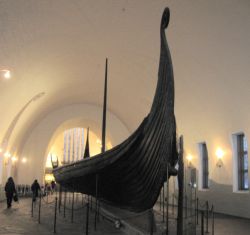
This is the Oseberg ship, so named for the place where it was found and excavated in 1904. It was built around 815–820 and sailed the Norwegian coast until it was used as the final resting place for a prominent woman who died in 834; buried with her were most valuable possessions and also, apparently, a serving woman. Thanks to the clay soil underneath and the mound of turf that was piled on top, these items survived the many centuries in remarkably good condition. A selection is displayed in what was once the church sanctuary: cart, sledge, small boats, home furnishings, tools and other implements, and even textiles. The Gokstad ship, on the left side of the transept, was likewise a burial site, this time of a prominent man, and his personal effects included a leather bridle ornamented with bronze. Leather from the ninth century! With its higher and sturdier sides, the Gokstad ship may have ventured further out on the open sea.
Both ships could be rowed (by as many as 32 men) or sailed -- that's a mast in the middle, on which would have been raised a single square sail. Imagine if you will striking out from Scandinavia across the North Sea in such a ship, across the North Atlantic to Iceland, Greenland, Newfoundland, and maybe New England. The Vikings also sailed around western Europe, through the Straits of Gibraltar, and into the Mediterranean; they traded along the great rivers of Russia, all the way to the Black Sea. And they left their mark on Britain, too, where many place-names in the north of England have Scandinavian origins.

Here's a view of the Oseberg ship from above. We're not talking cabins here, or even berths.
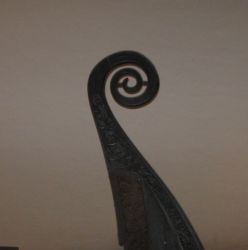 |
This is the ornately carved prow of the Oseberg ship. |
I'm not a big souvenir buyer, but I couldn't resist a mug from the Viking museum. It's tall and graceful, wider at the top than the bottom, and an image of the Oseberg ship is wrapped around it. "Vikingskiphuset" is printed on the handle. I'm drinking my morning tea from it now.
American Abroad
December 09, 2010 - View Single Entry
When they're headed off-island, some people on Martha's Vineyard like to say that they're "going to America." They're joking, or being facetious, or at least speaking lightly -- I hope -- but the words we use tend to take root in our heads so I just tell people that I'm going off-island. Martha's Vineyard is inextricably part of America, not least in the penchant of some of its people to pretend that they live in some other country.
When you're packing a passport whose cover is embossed with UNITED STATES OF AMERICA and the national seal, it's impossible to pretend that you belong to some other country.
My first day in Oslo, Lynn and I headed downtown from my hotel. Strolling along Henrik Ibsens gate (at that point I didn't know what the street's name was), approaching the Slottsparken -- where the royal palace is -- on the left, I was dimly aware of a huge building on my right that took up the whole block and was surrounded by a high black fence.
|

|
When I took this and the following pictures, on my last full day in Norway, it was almost 4 p.m. and pitch-dark. Lightening them made the details visible, but it also belies the blackness of the fence and the fortress-like weight of the building. |
Keep in mind that this is in the embassy district, near the palace -- a dignified, sometimes elegant area much frequented by visitors. The fence surrounds the entire building. It was erected in the wake of 9/11 to deter terrorists, who are not much in evidence in Oslo. The controversy that followed its building has died down, but its statement to the neighborhood, to Oslo, to Norway, to the world, remains visceral and clear. It made me wish I belonged to some other country.
 |
If a U.S. citizen lost her passport, maybe they'd let her in here. |
|
Yes, Christmas has been allowed to breach the fence. But there were no footprints in the snow near these steps. This entrance is for show only. The whiteness of the fence is the product of reflected light. |
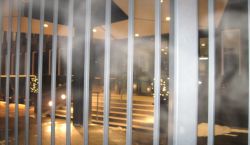 |
 |
When you walk down Henrik Ibsens gate, the fence shadows you like a basketball defenseman. He wants to keep you from shooting; you don't want to shoot, or look in his direction, or even acknowledge his existence. But your shadow is there, hovering, blocking, no matter what you want. |
 |
Small Differences
December 08, 2010 - View Single Entry
In my jeans, boots, and old blue parka, I didn't look out of place on the streets of Oslo. The people on the streets and buses of Oslo looked so familiar that it was a little startling to realize that I couldn't eavesdrop on their conversations. Most of them, however, could have eavesdropped quite well on any conversation I had in English.
Signs I could often decipher. "Julmarked" and "God jul" weren't hard. But "Lufting av hund er forbudt"? "Hund" and "forbudt" were easy, but didn't "luft" have something to do with air? Indeed it did. If you don't want a dog to do its business on your sidewalk, fence, or flowerbed, you post a sign warning that airing dogs is forbidden.
Lynn met me at the airport, I changed US$100 into 500 Norwegian kroner (NOK), and we took the airport train into town, to "Oslo S," the central railway station. Across the fields the snow-gilded firs were straight out of a picture postcard; they looked the same when I left almost a week later. Riding the train was just as amazing. You swipe your credit card once at the beginning of your trip and again when you exit the station at your destination. No money changes hands, no change need be made -- and once you register with Flytoget, which runs the train, you can download a receipt for your journey. One-way passage was 170 NOK, or about $28.35. More expensive than the regular bus, but who wants to wrestle two suitcases and a laptop on a regular bus?
We took a taxi from Oslo S to Gabelshus, my hotel, on Gabelsgate in the upscale embassy district. My room wasn't ready yet, so we left my bags in the office and went walking. Lynn guided me through the purchase of a bus pass, good for one week's unlimited travel on buses, streetcars, or the tube. It cost 210 NOK, about US$35. What a wonder. There are card readers on most of the buses: you swipe the front of the card over the reader and the reader logs you in/on. Again, no cash changes hands.
The big difference between Oslo and the U.S. cities I know best, D.C. and Boston, wasn't the language; it was the nearly complete absence of cash from day-to-day transactions. And checks. On Martha's Vineyard, checks are generally accepted (maybe this is a small-town thing?), but I'm using them a lot less than I was two years ago. I use a debit card for groceries and at the post office; I pay most of my bills electronically. The Norwegians, and Europeans generally, are way, way ahead of us on this one. In Oslo I paid cab drivers with a credit card, bought meals and museum admissions and various goods with a credit card. My slippers required cash, and so did my bus pass, but that was about it.
I don't know if my debit/ATM card would have worked in the local ATM/minibanks because I didn't need more cash than I'd got at the airport on arrival.
My hotel room included buffet breakfast, which I took advantage of all three mornings I was there, and supper, which I only had on my first night. The food was very good, and the bread was excellent. (All the bread I ate in Norway was excellent -- and that's the verdict of a bread baker.)
My room itself was cozy and complete, more like a room than a hotel room. The bed was made up with a sheet, duvet and cover, and one pillow. (Inn on the Square in Falmouth had four pillows on each bed.)
|
Here's my (rumpled) bed with a view out the window. My first morning I set my alarm for 7 a.m., but my brain swore it was way too dark to wake up so I fell back to sleep. When I woke again, it was a little after 8 and almost as dark, but then my brain remembered that I was supposed to be meeting my colleagues at 9 halfway across a town I'd only just met. Since there are only six hours of daylight in Oslo this time of year, this view out the window is unusual. |
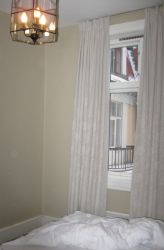 |
 |
Here's Hekate the laptop set up on my desk. Wi-fi was free. Guess who never turned the TV on? The pole lamp I moved to its position because the lightbulb in the desk lamp was burned out and I kept forgetting to ask for another one. |
| Bathrooms are a little different in Norway. No shower curtains. Instead there's a glass or glass-like shield that extends halfway along the edge of the tub to keep water from splashing out. No bathmat or washcloth was provided. Shampoo and soap were provided in dispensers attached to the wall, not in little plastic bottles. A little "Be Green" sign urged guests to reuse their towels instead of getting clean ones every day. I was properly green. |
 |
My hotel room, like just about every indoor space I was in, was considerably warmer than the average indoor space at home. At home I expect to have a couple layers of clothing on indoors this time of year. In Norway, I'm told, the idea is that the indoor temperature should be conducive to wearing only a T-shirt. I did indeed see people wearing not much more than that. Norway, I'm also told, has mostly clean energy, from hydroelectric power, so this may be part of the reason. I don't know what Norwegians pay for heat in the winter, and I wasn't there long enough to know if they talk about the cost of heat anywhere near as much as people at home do.
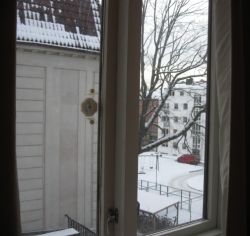
That was the view from my window. There was a little snow on the ground when I arrived, and a little snow on the ground when I left, but it didn't snow while I was there.
|

